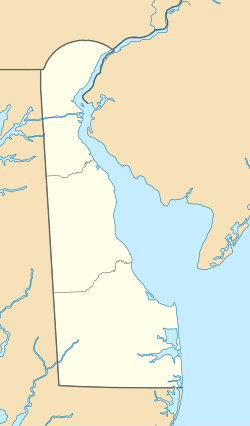Welsh Tract Baptist Church
|
Welsh Tract Baptist Church
|
|

Welsh Tract Baptist Church, October 2012
|
|
| Location | Welsh Tract Rd., Newark, Delaware |
|---|---|
| Coordinates | 39°39′1″N 75°45′7″W / 39.65028°N 75.75194°WCoordinates: 39°39′1″N 75°45′7″W / 39.65028°N 75.75194°W |
| Area | 5 acres (2.0 ha) |
| Built | 1746 |
| NRHP Reference # | 73000527 |
| Added to NRHP | March 1, 1973 |
Welsh Tract Baptist Church is a historic Baptist church on Welsh Tract Road in Newark, New Castle County, Delaware. It was built by Welsh settlers in 1746 and is a simple rectangular brick building with a wood-shingled jerkinhead roof.
The Baptist movement had gained significant ground in England and Wales during the religious turmoil that embroiled the British Isles through the 17th century. Although the Tolerance Act was passed by the English Parliament in 1689 in an attempt to end the religious strife, by the end of that century, new efforts were being made by the English Crown to reinforce the hegemony of the Anglican church over all "Dissenter" groups in the realm. In the spring of 1701, sixteen Baptists, in the counties of Pembroke and Carmarthen, South Wales, resolved to go to America. They formed themselves into a church, with Thomas Griffith, one of their number, as Pastor. They embarked at Milford Haven in June, 1701, arriving in Philadelphia September, 8th, the same year. Local Baptist leaders advised them to join an established congregation nearby along the Pennepeck Creek.
The immigrant group settled there for about a year and a half. During that time they kept together as a distinct church, held meetings at each other’s residences, and observed the ordinances of Christ in a manner they had brought with them from Wales. In the two years, twenty-one persons were added to their number.
The ceremony of laying on of hands was the principal, if not sole, means of introducing singing, imposition of hands, church covenants, etc., among Welsh Baptists, and they maintained that practice in Pennsylvania. But not without some difficulty, as appears from the following history translated from the Welsh Tract book:
“But we could not be in fellowship (at the Lord’s table) with our brethren in Pennypack and Philadelphia, because they did not hold to the laying on of hands, and some other particulars relating to a church; true, some of them believed in the ordinance, but neither preached it nor practiced it; and when we moved to Welsh Tract, and left twenty-two of our members at Pennypack, and took some of their members down with us, the difficulty increased. We had many meetings to compromise matters, but to no purpose, till June 22d, 1706; then the following deputies (naming twenty-five persons) met at the house of Bro. Richard Miles, in Radnor, Delaware County, Pa., and agreed
But three years after this meeting we had reason to review the transaction, because of some brethren who arrived from Wales, and one among ourselves, who questioned whether the first article was warrantable; but we are satisfied that all was right, by the good effects which followed: for from that time forth our brethren held sweet communion together at the Lord’s table, and our minister, Rev. Thomas Griffiths [sic], was invited to preach and assist at an ordination at Pennypack, after the death of our Bro. Watts. He proceeded from thence to the Jerseys, where he enlightened many in the good ways of the Lord, insomuch that, in three years after, all the ministers and about twenty- five private members had submitted to the ordinance.”
...
Wikipedia


